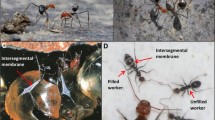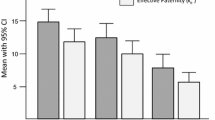Abstract
The dwarf honey bees Apis florea and A. andreniformis are sympatric in southeast Asia. We translocated eight A. florea colonies and four A. andreniformis colonies to an orchard near Sai Yoke, Thailand. After 2 days, we dequeened half of the colonies. Microsatellite genotyping showed that a queenless A. florea colony merged with a queenright A. florea colony, and a queenless A. andreniformis colony merged with a queenright A. florea colony. The inter-specific merger in particular shows that colonies can combine without direct kin benefits, and that colony mergers probably arise through strong queen attraction.
Similar content being viewed by others
References
Beekman M. and Oldroyd B.P. 2008. When workers disunite: Intraspecific parasitism in eusocial bees. Annu. Rev. Entomol. 53: 19–37
Boomsma J.J. 2007. Kin selection versus sexual selection: why the ends do not meet. Curr. Biol. 17: R673–R683
Breed M.D., Deng X.-B. and Buchwald R. 2007. Comparative nestmate recognition in Asian honey bees, Apis florea, Apis andreniformis, Apis dorsata, and Apis cerana. Apidologie 38: 411–418
Brian M.V. 1986. Bonding between workers and queens in the ant genus Myrmica. Anim. Behav. 34: 1135–1145
Chapman N.C., Beekman M. and Oldroyd B.P. 2009a. Worker reproductive parasitism and drift in the Western honeybee Apis mellifera. Behav. Ecol. Sociobiol. (in press)
Chapman N.C., Higgs J.S., Wattanachaiyingcharoen W., Beekman M. and Oldroyd B.P. 2009b. Worker reproductive parasitism in naturally orphaned colonies of the Asian red dwarf honey bee, Apis florea. Insect. Soc. (in press)
Chapman N.C., Nanork P., Gloag R.S., Wattanachaiyingcharoen W., Beekman M. and Oldroyd B.P. 2009c. Queenless colonies of the Asian red dwarf honey bee (Apis florea) are infiltrated by workers from other queenless colonies. Behav. Ecol. 20: 817–820
Engel M.S. 1999. The taxonomy of recent and fossil honey bees (Hymenoptera: Apidae; Apis). J. Hymen. Res. 8: 165–196
Estoup A., Garnery L., Solignac M. and Cornuet J.-M. 1995a. Microsatellite variation in honey bee (Apis mellifera L.) populations: Hierarchical genetic structure and tests of the infinite allele and stepwise mutation models. Genetics 140: 679–695
Estoup A., Scholl A., Pouvreau A. and Solignac M. 1995b. Monandry and polyandry in bumble bees (Hymenoptera: Bombinae) as evidenced by highly variable microsatellites. Mol. Ecol. 4: 89–93
Estoup A., Solignac M. and Cornuet J.-M. 1994. Precise assessment of the number of patrilines and of genetic relatedness in honey bee colonies. Proc. R. Soc. Lond B 258: 1–7
Foitzik S. and Heinze J. 1998. Nest site limitation and colony takeover in the ant Leptothorax nylanderi. Behav. Ecol. 9: 367–375
Godzinska E.J. 1989. Extra-colony altruism in the bumblebees: misbehaviour or adaptation? Actes Coll. Insectes Soc. 5: 161–167
Halling L.A., Oldroyd B.P., Wattanachaiyingcharoen W., Barron A.B., Nanork P. and Wongsiri S. 2001. Worker policing in the bee Apis florea. Behav. Ecol. Sociobiol. 49: 509–513
Hamilton W.D. 1964. The genetical evolution of social behaviour. I & II. J. Theor. Biol. 7: 1–52
Hamilton W.D. 1972. Altruism and related phenomena, mainly in social insects. Annu. Rev. Ecol. Syst. 3: 193–232
Higgs J.S., Wattanachaiyingcharoen W. and Oldroyd B.P. 2009. A scientific note on a genetically-determined colour morph of the dwarf honey bee, Apis andreniformis (Smith, 1858). Apidologie 40: 513–514
Hughes W.O.H., Oldroyd B.P., Beekman M. and Ratnieks F.L.W. 2008 Ancestral monogamy shows kin selection is key to the evolution of eusociality Science 320:1213–1216
Jones J.C., Nanork P. and Oldroyd B.P. 2007. The role of genetic diversity in nest cooling in a wild honey bee, Apis florea. J. Comp. Physiol. A 193: 159–165
Kaminski L.A., Slessor K.N., Winston M.L., Hay N.W. and Borden J.H. 1990 Honeybee response to queen mandibular pheromone in laboratory bioassays. J. Chem. Ecol. 16: 841–850
Kasuya E. 1981. Internidal drifting of workers in the Japanese paper wasp Polistes chinensis antennalis (Vespidae, Hymenoptera). Insect. Soc. 28: 343–346
Kellner K., Barth B. and Heinze J. 2010. Colony fusion causes within-colony variation in a parthenogenetic ant. Behav. Ecol Sociobiol. (in press)
Ken T., Mingxian Y., Radloff S.E., Pirk C.W.W., Crewe R.M., Phiancharoen M., Hepburn R. and Oldroyd B.P. 2009. Worker reproduction in mixed-species colonies of honey bees. Behav. Ecol. 20: 1106–1110
Koeniger N. and Koeniger G. 2000. Reproductive isolation among species of the genus Apis. Apidologie 31: 313–339
Kronauer D.J.C., Schöning C., d’Ettorre P. and Boomsma J.J. 2009. Colony fusion and worker reproduction after queen loss in army ants. Proc. R. Soc. 277: 755–763
Lopez-Vaamonde C., Koning J.W., Brown R.M., Jordan W.C. and Bourke A.F.G. 2004. Social parasitism by male-producing reproductive workers in a eusocial insect. Nature 430: 557–560
Nanork P., Paar J., Chapman N.C., Wongsiri S. and Oldroyd B.P. 2005. Asian honey bees parasitize the future dead. Nature 437: 829
Nanork P., Wongsiri S. and Oldroyd B.P. 2007. Preservation and loss of the honey bee (Apis) egg-marking signal across evolutionary time. Behav. Ecol. Sociobiol. 61: 1509–1514
Neumann P., Pirk C.W.W., Hepburn H.R. and Radloff S.E. 2001. A scientific note on the natural merger of two honeybee colonies (Apis mellifera capensis). Apidologie 32: 113–114
Neumann P., Radloff S.E., Pirk C.W.W. and Hepburn H.R. 2003. The behaviour of drifted Cape honeybee workers (Apis mellifera capensis): predisposition for social parasitism? Apidologie 34: 585–590
O’Donnell S. 1992. Time-sharing, drifting, and pilfering: inter-nest activities of Polybia occidentalis foragers. Sphecos 23: 4
Oldroyd B.P. and Beekman M. 2008. Effects of selection for honey bee worker reproduction on foraging traits. PLoS Biol. 6: e56 doi: 10.1371/journal.pbio.0060056
Oldroyd B.P., Clifton M.J., Wongsiri S., Rinderer T.E., Sylvester H.A. and Crozier R.H. 1997. Polyandry in the genus Apis, particularly Apis andreniformis. Behav. Ecol. Sociobiol. 40: 17–26
Oldroyd B.P., Gloag R.S., Even N., Wattanachaiyingcharoen W. and Beekman M. 2008. Nest site selection in the open-nesting honeybee Apis florea. Behav. Ecol. Sociobiol. 62: 1643–1653
Oldroyd B.P., Smolenski A.J., Cornuet J.-M., Wongsiri S., Estoup A., Rinderer T. and Crozier R.H. 1995. Levels of polyandry and intracolonial genetic relationships in Apis florea. Behav. Ecol. Sociobiol. 37: 329–335
Oldroyd B.P. and Wongsiri S. 2006. Asian Honey Bees. Biology, Conservation and Human Interactions. Harvard University Press, Cambridge, MA. 340 pp
Palmer K.A. and Oldroyd B.P. 2001. Mating frequency in Apis florea revisited (Hymenoptera: Apidae). Insect. Soc. 48: 40–43
Pfeiffer K.J. and Crailsheim K. 1999 The behaviour of drifted nurse honey bees. Insect. Soc. 46:34–40
Rinderer T.E., Oldroyd B.P., Wongsiri S., Potichot S., Sheppard W.S. and Buchmann S. 1993. Time of drone flight in four bee species in south-eastern Thailand. J. Apic. Res. 32: 27–33
Rinderer T.E., Wongsiri S., Kuang B., Liu J., Oldroyd B.P., Sylvester H.A. and de Guzman L. 1996. Comparative nest architecture of the dwarf honey bees. J. Apic. Res. 35: 19–26
Roubik D.W. 1981. A natural mixed colony of Melipona (Hymenoptera: Apidae). J. Kans. Ent. Soc. 54: 263–268
Slessor K.N., Kaminski L.A., King G.G.S., Borden J.H. and Winston M.L. 1988. Semiochemical basis of the retinue response to queen honey bees. Nature 332: 354–356
Solignac M., Mougel F., Vautrin D., Monnerot M. and Cornuet J.-M. 2007. A third-generation microsatellite-based linkage map of the honey bee, Apis mellifera, and its comparison with the sequence-based physical map. Gen. Biol. 8: R66. doi:10.1186/gb-2007-8-4-r66)
Sumner S., Lucas E., Barker J. and Isaac N. 2007. Radio-tagging technology reveals extreme nest-drifting behavior in a eusocial insect. Cur. Biol. 17: 140–145
Tan K., Yang M., Radloff S.E., Yu Y., Pirk C.W.W. and Hepburn H.R. 2009. Intra- and interspecific brood recognition in pure and mixed-species honeybee colonies, Apis cerana and A. mellifera. Apidologie 40: 184–191
Vargo E.L. 1999. Reproductive development and ontogeny of queen pheromone production in the fire ant Solenopsis invicta. Physiol. Entomol. 24: 370–376
Wattanachaiyingcharoen W., Wongsiri S. and Oldroyd B.P. 2008. Aggregations of unrelated Apis florea colonies. Apidologie 39: 531–536
Wongvilas S., Higgs J.S., Beekman M., Wattanachaiyingcharoen W., Deowanish S. and Oldroyd B. 2010. Lack of inter-specific parasitism between the dwarf honeybees Apis andreniformis and A. florea. Behav. Ecol. Sociobiol. (in press)
Acknowledgments
We thank Madeleine Beekman for comments on this manuscript. The work was supported by an Australian Research Council grant to M. Beekman and B. Oldroyd and by the TRF/BIOTEC Special Program for Biodiversity Research and Training, grant BRT R251137.
Author information
Authors and Affiliations
Corresponding author
Electronic supplementary material
Below is the link to the electronic supplementary material.
Rights and permissions
About this article
Cite this article
Wongvilas, S., Deowanish, S., Lim, J. et al. Interspecific and conspecific colony mergers in the dwarf honey bees Apis andreniformis and A. florea . Insect. Soc. 57, 251–255 (2010). https://doi.org/10.1007/s00040-010-0080-7
Received:
Revised:
Accepted:
Published:
Issue Date:
DOI: https://doi.org/10.1007/s00040-010-0080-7




